? ? Sun news for May 13, 2024: High flare and auroral potential continues
? The chance for X flaring remains the highest seen in Solar Cycle 25 at 75%. Wow!
? ? ? Wait and see what is next from the sun and here on Earth.
? MORE at EarthSky: https://t.co/xD29wLfm4e pic.twitter.com/3KijGbb7hJ
— Dr. C. Alex Young (@TheSunToday) May 13, 2024
Video: Are blasts from the sun affecting YOU?
Sun news for May 13, 2024: High X flare potential today!
Today’s top story: The X flare potential today remains at 75%, the highest we’ve seen in Solar Cycle 25 so far (not counting yesterday). Wow! This weekend’s solar superstorm may be over, but coronal mass ejections – or CMEs, or massive chunks of sun material – continue to travel toward Earth. We don’t expect G4 (severe) or G5 (extreme) storms at this time. But at least G3 (moderate) geomagnetic storming is in the forecast. For those of you who’ve asked, another G5 (extreme) storm is unlikely in the coming few days, but surprises are still possible. If you have photos from this weekend’s storm, please submit them to our community page! Finally, enjoy some of the photos we’ve already received from the weekend, in this beautiful gallery.
Last 24 hours: Sun activity is high with the production of an X flare and 12 M flares between 11 UTC yesterday and 11 UTC today. These flares are all produced by AR3664, which remains the largest and most complex region on the solar disk. AR3675 and AR3676 grew, and new regions AR3677, AR3678, and AR367 were numbered. Over the last 24 hours, the sun produced 23 flares: the X flare, 12 M flares, and ten C flares. The breakdown of X and M flares is:
– X1.5 by AR3664 at 11:15 UTC, May 11. R3 (strong) radio blackout over Africa.
– M1.7 by AR3664 at 12:27 UTC on May 12. R1 (minor) radio blackout over Africa.
– M1.0 by AR3664 at 13:40 UTC on May 12. R1 (minor) radio blackout over the Atlantic Ocean.
– M1.6 by AR3664 at 13:47 UTC on May 12. R1 (minor) radio blackout over the Americas.
– X1.0 by AR3664 at 16:11 UTC on May 12. R3 (strong) radio blackout over the Americas.
– M4.9 by AR3664 at 20:17 UTC on May 12. R1 (minor) radio blackout over the Pacific Ocean.
– M1.1 by AR3664 at 22:01 UTC on May 12. R1 (minor) radio blackout over the Pacific Ocean.
– M1.1 by AR3664 at 22:07 UTC on May 12. R1 (minor) radio blackout over the Pacific Ocean.
– M1.0 by AR3664 at 23:00 UTC on May 12. R1 (minor) radio blackout over the Pacific Ocean.
– M1.3 by AR3664 at 01:23 UTC on May 13. R1 (minor) radio blackout over Africa.
– M1.2 by AR3664 at 08:06 UTC on May 13. R1 (minor) radio blackout over Africa.
– M1.5 by AR3664 at 08:23 UTC on May 13. R1 (minor) radio blackout over Africa.
– M5.0 by AR3664 at 08:47 UTC on May 13. R2 (moderate) radio blackout over Africa.
– M6.7 by AR3664 at 09:36 UTC on May 13. R2 (moderate) radio blackout over Africa.
So AR3664 is again the lead flare producer. It produced all but two of the flares of the period. It produced nine flares: one X, 12 Ms, and nine Cs. A filament erupted off the north pole around 11:00 UTC on May 12, 2024, and an eruption occurred off the western limb around the back side of AR3664 around 8:35 UTC on May 13, 2024. The geomagnetic field reached G3 (strong) geomagnetic storm levels early in the UTC due to continued CME activity. After periods of unsettled to active levels, responses increased to G2 (moderate) levels late in the reporting period. The sun currently has 12 labeled regions on its Earth-facing side.
Next 24 hours: Chances for C flares is 99%. The chance for M flares is 95%. And the chance for more X flares is still a whopping 75% today.
Next expected CME: We are still waiting for more of the many coronal mass ejections (CMEs) originating from AR3664 to reach Earth. A CME was first visible in LASCO C2 imagery May 12 at 1:48 UTC off the southeast. It appears to be related to nearly simultaneous eruptions from regions AR3673 and AR3676 early in the period. This CME is likely to result in a glancing blow at Earth late on May 14 or early on May 15.
Current geomagnetic activity: Earth’s magnetic field is unsettled at the time of this writing (11 UTC on May 13). Periods of G2-G3 (moderate-strong) geomagnetic storms are likely on May 13 due to anticipated CME passages from multiple eruptive events originating from Region 3664, in addition to weak influence of high-speed solar wind from coronal holes. Active conditions and G1 (minor) storms are likely on May 14 due to the weak influence of fast solar wind and the possible glancing blow arrival of a CME from May 12. Unsettled and active levels are expected on May 15, with continued solar wind influences and possible waning CME influences.
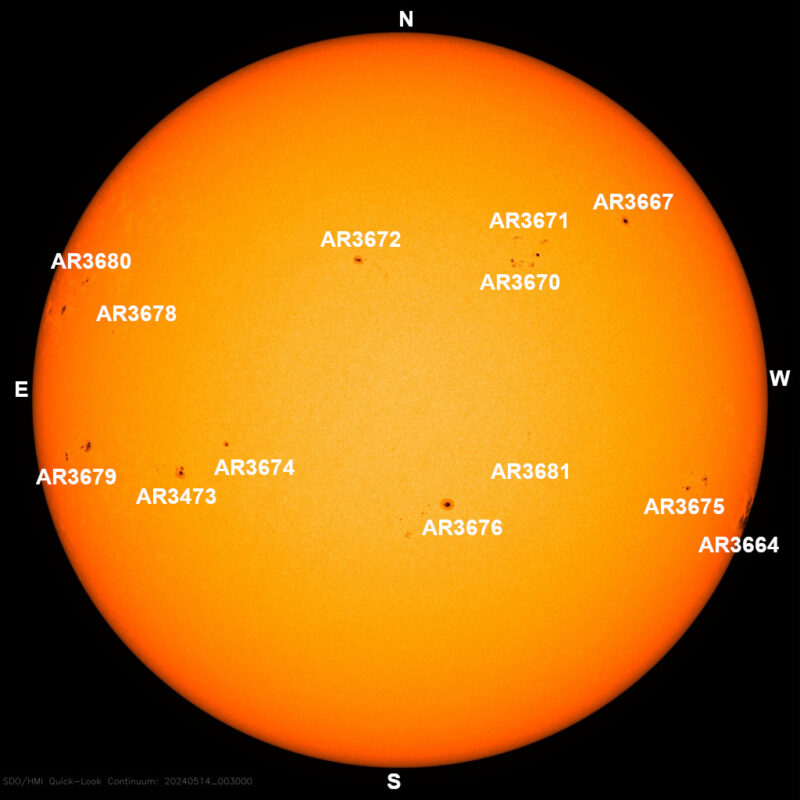
See an EarthSky photo gallery of the aurora superstorm from May 10 to 11, 2024!
Sun news for May 12, 2024: X flare potential is high. Plus, more auroras tonight?
The chances for more X flares today remain the highest we have seen in Solar Cycle 25 so far: 75%! See “next 24 hours,” below. Last night didn’t see the auroral explosion of the night before. But if you missed Friday’s auroras, don’t give up! More corona mass ejections (CMEs) are on the way. And that means more auroras coming! The X5.8 flare from May 11 had a large, fast CME associated with it, and that CME is on its way to us. We expect the CME to join the several still in route to Earth. NOAA has forecast that this soup of CMEs will reach Earth mid-day today (Sunday, May 12). That is around 12 UTC or 8 am EDT. Currently, the prediction is for a G4 (severe) to G5 (extreme) geomagnetic storm. Remember that originally NOAA only predicted a G4 (severe) storm? But the world experienced a G5 (extreme) storm with all the auroral excitement! Get ready, because we may have another chance for a spectacular show tonight. Fingers crossed for clear skies! If you do take aurora photos tonight or have already taken some, share them with our community! Finally, enjoy some of the photos we’ve already received from last night in this beautiful gallery.
Last 24 hours:Sun activity is still very high with the production of an X flare and six M flares between 11 UTC yesterday and 11 UTC today. There is an ongoing radiation storm from the X5.8 flare, but that is dying down. At 11:15 UTC, May 11, the sun released an X1.5 from our old friend AR3664. Over the last 24 hours, the sun produced 12 flares: the X flare, six M flares, and seven C flares. The breakdown of X and M flares is:
-X1.5 by AR3664 at 11:15 UTC, May 11. R1 (strong) radio blackout over Africa.
-M1.8 by AR3664 at 13:45 UTC on May 11. R1 (minor) radio blackout over Mexico.
-M8.9 by AR3664 at 14:46 UTC on May 11. R1 (moderate) radio blackout over the west coast of Mexico.
-M3.0 by AR3664 at 16:24 UTC on May 11. R1 (minor) radio blackout over the west coast of Mexico.
-M1.2 by AR3664 at 20:32 UTC on May 11. R1 (minor) radio blackout over the Pacific Ocean.
-M3.2 by AR3664 at 00:41 UTC on May 12. R1 (minor) radio blackout over the Pacific Ocean.
-M2.4 by unnumbered at 1:23 UTC on May 12. R1 (minor) radio blackout over Asia .
So AR3664 is the lead flare producer. It produced all but three of the flares of the period. It produced nine flares: one X, five Ms, and three Cs. A beautiful filament erupted off the south pole around 11:45 UTC on May 11, 2024. The sun currently has five labeled regions on its Earth-facing side.


Sun news for May 11, 2024: Solar superstorm is ongoing. More auroras tonight?
WOW! Last night, there was an auroral explosion across the globe. The anticipated geomagnetic storm reached levels much higher than expected. But if you missed it, there’s a good chance for more tonight. Overnight, the level of geomagnetic activity climbed to a G5 (extreme) storm. A series of coronal mass ejections (CMEs) arrived a bit earlier than anticipated, reaching us late yesterday, May 10. It appears that one or more CMEs overtook an earlier, slower CME, creating a cannibal event. And this event bumped the geomagnetic disturbance to unexpected levels. So much so that it has now become the largest geomagnetic storm in the past 20 years and the largest of Solar Cycle 25 so far! It has reached the level of a solar “superstorm” and is only slightly smaller than the famous November 2003 Halloween superstorm. Reports of aurora first came in from across Europe and New Zealand. Next, auroras reached the Americas, including as far south as Mexico, the Florida Keys, and the Bahamas, and as far north in the Southern Hemisphere as Chile and Argentina. We’ll probably see more activity tonight, though currently it looks like the strongest activity has passed. But this could change! We have additional CMEs on the way, including some not yet been completely analyzed. An X5.8 flare yesterday (the second strongest of the cycle!) had a large coronal wave associated with it, which could indicate a large, fast CME. We’re also expecting high-speed solar wind from a coronal hole to reach Earth this weekend. Combined, these factors could bring extended superstorm activity. We’ll have to wait and see. If you took aurora photos, share them with EarthSky! And enjoy some of the photos we’ve already received from last night in this beautiful gallery. Stay tuned.
Last 24 hours: Sun activity is very high with the production of an X flare and a whole host of M flares. At 1:23 UTC today, May 11, the sun released the only X flare of the period, an X5.8 from active region AR3664, between 11 UTC yesterday and 11 UTC today. This X5.8 is just a hair smaller than the biggest X flare we have seen so far during Solar Cycle 25, an X6.4 flare from AR3590 back on February 22. Over the last 24 hours, the sun produced 15 flares: the X flare, 11 M flares, and three C flares. The breakdown of X and M flares is:
-M6.0 by AR3664 at 14:12 UTC, May 10. R1 (minor) radio blackout over Niger.
-M1.1 by AR3664 at 18:32 UTC on May 10. R1 (minor) radio blackout over Mexico.
-M1.8 by AR3664 at 18:48 UTC on May 10. R1 (minor) radio blackout off the west coast of Mexico.
-M2.0 by AR3664 at 19:05 UTC on May 10. R1 (minor) radio blackout over the west coast of Mexico.
-M1.1 by AR3664 at 19:53 UTC on May 10. R1 (minor) radio blackout over the Pacific Ocean.
-M1.9 by AR3664 at 20:03 UTC on May 10. R1 (minor) radio blackout over the Pacific Ocean.
-M3.8 by AR3664 at 21:08 UTC on May 10. R1 (minor) radio blackout over the Pacific Ocean east of Hawaii.
-X5.8 by AR3664 at 1:23 UTC on May 11. R3 (strong) radio blackout over the Philippine Sea.
-M1.4 by AR3664 at 4:40 UTC on May 11. R1 (minor) radio blackout over the South China Sea.
-M3.1 by AR3664 at 10:18 UTC on May 11. R1 (minor) radio blackout over Africa.
-M1.6 by AR3654 at 10:56 UTC on May 11. R1 (minor) radio blackout over Africa.
AR3664 is the lead flare producer. It produced all but one of the flares of the period. It produced 14 flares: one X, nine Ms, and four Cs. This active region goes also was the lead contributor to the largest geomagnetic storm of Solar Cycle 25 so far, a G5 or Kp = 9. The sun currently has five labeled regions on its Earth-facing side.

Sun news for May 10, 2024: Severe solar storm to bring auroras!
The EarthSky sun news team created this video for you.
This could be a big one! Severe geomagnetic storming is forecast, starting later today. We expect the arrival of a series of at least five coronal mass ejections (CMEs, great burps of material from the sun), all released by this week’s X- and M-flare activity. Should you be afraid? No. So far, this is ordinary behavior from our sun at Solar Maximum, which happens about every 11 years. G2 (moderate), G3 (strong), and up to G4 (severe) conditions are expected. This will bring chances for auroral displays to middle and possibly even low northerly latitudes! Highly active auroral displays will be visible overhead from places including Inuvik, Vancouver, Washington, Michigan, Montpelier, Tromsø, the UK and Russia, and visible low on the horizon in places such as Indiana, California, Brussels, Warsaw, Wellington, and Hobart. Wishing you all clear skies!
Last 24 hours: Sun activity remains very high, with a case of solar deja vu; just like yesterday, our star blasted two X flares and a whole host of M flares. The strongest event was an X4.0 flare from AR3664 at 6:54 UTC on May 10. AR3664 also released an X1.1 flare at 17:44 UTC on May 9. Ejecta associated with the X1.1 soared into space during the event. We will await the results of modeling and analysis to see if there is an Earth-directed component. Between 11 UTC yesterday and 11 UTC today, the sun produced 16 flares: two X flares, 12 M flares, and two C flares. The breakdown of X and M flares is:
-M4.1 by AR3663 at 11:22 UTC, May 8. R1 (minor) radio blackout over Niger.
-M3.1 by an unnumbered region in the southwest at 11:56 UTC on May 9. R1 (minor) radio blackout over Mali.
-M2.9 by AR3664 at 12:12 UTC on May 9. R1 (minor) radio blackout over Mauritania.
-M3.7 by AR3664 at 13:23 UTC on May 9. R1 (minor) radio blackout over the Atlantic Ocean off west Africa.
-X1.1 by AR3664 at 17:44 UTC on May 9. R3 (strong) radio blackout over Cancun in Mexico.
-M1.0 by AR3663 at 21:21 UTC on May 9. R1 (minor) radio blackout over the Pacific Ocean.
-M1.0 by AR3663 at 22:15 UTC on May 9. R1 (minor) radio blackout over Hawaii.
-M2.6 by an unnumbered region in the southwest at 22:41 UTC on May 9. R1 (minor) radio blackout over Hawaii.
-M1.2 by an unnumbered region in the southeast at 23:08 UTC on May 9. R1 (minor) radio blackout over the Pacific Ocean west of Hawaii.
-M1.6 by AR3664 at 23:51 UTC on May 9. R1 (minor) radio blackout over the Pacific Ocean.
-M1.5 by AR3664 at 0:18 UTC on May 10. R1 (minor) radio blackout over the Pacific Ocean.
-M1.5 by an unnumbered region in the southeast at 3:29 UTC on May 10. R1 (minor) radio blackout over the Philippines.
-M1.4 by AR3664 at 6:24 UTC on May 10. R1 (minor) radio blackout over northeast India.
-X4.0 by AR3664 at 6:54 UTC on May 10. R3 (strong) radio blackout over northwest India. (The strongest)
-M2.2 flare by AR3664 at 10:14 UTC on May 10. R1(minor) radio blackout over Egypt.
AR3664 took the lead in flare production for the period, with nine flares: two X flares, six M flares, and a C flare. The sun currently has seven labeled regions on its Earth-facing side. There are two newcomers in the northeast quadrant: AR3671 and AR3672.
? ? Sun news for May 10, 2024: Severe solar storm to bring auroras!
? ? ? Strong to severe geomagnetic activity is anticipated starting later today into tomorrow.
Chances for auroral displays to mid and low latitudes!
? MORE at EarthSky: https://t.co/xD29wLfm4e pic.twitter.com/lEQTd2BDMo
— Dr. C. Alex Young (@TheSunToday) May 10, 2024
Sun news for May 9, 2024: Two X flares and M flares all day long
Our star is keeping up its very high activity, with AR3664 firing off two more X flares over the past day. The first, an X1.0, came at 21:08 UTC last night, followed less than an hour later by an M9.9 – just on the threshold of another X flare. The second X flare of the past 24 hours was an X2.3, fired again by AR3664 at 9:11 UTC this morning. This flare appears to have a fast coronal mass ejection (CME) associated with it, according to radio burst observations, but we await SOHO LASCO observations to verify this. The region has been firing off large M flares all day and has now surpassed AR3663 as the primary region to watch. More is surely on the way! Stay tuned.
Last 24 hours: Very high sun activity continues with two X flares and a long list of M flares. Between 11 UTC yesterday and 11 UTC today, the sun produced 19 flares: two X flares, 15 M flares, and two C flares. The largest was an X2.3 flare from AR3664 at 9:11 UTC on May 9. Earlier, we saw the above-mentioned X1.0 flare from AR3664 at 21:08 UTC on May 8. This is the breakdown of X and M flares during our observation period:
-M4.1 by AR3663 at 11:22 UTC, May 8. R1 (minor) radio blackout over Niger.
-M8.7 by AR3664 at 12:04 UTC, May 8. R2 (moderate) radio blackout over Mauritania.
-M1.1 by AR3662 at 14:43 UTC, May 8. R1 (minor) radio blackout over the Atlantic Ocean.
-M7.9 by AR3668 at 17:53 UTC, May 8. R2 (moderate) radio blackout over Cancun in Mexico.
-M2.9 by AR3662 at 18:36 UTC, May 8. R1 (minor) radio blackout over Mexico.
-M2.0 by AR3664 at 19:21 UTC, May 8. R1 (minor) radio blackout over Pacific Ocean off west coast Mexico.
-M1.8 by AR3664 at 20:34 UTC, May 8. R1 (minor) radio blackout over the Pacific Ocean.
-X1.0 by AR3664 at 21:40 UTC, May 8. R3 (strong) radio blackout over the Pacific Ocean east of Hawaii.
-M9.9 by AR3664 at 22:27 UTC, May 8. R2 (moderate) radio blackout over Hawaii.
-M4.0 by AR3664 at 3:17 UTC, May 9. R1 (minor) radio blackout over the Philippine Sea.
-M4.6 by AR3664 at 3:32 UTC, May 9. R1 (minor) radio blackout over the Philippine Sea.
-M1.7 by AR3664 at 4:49 UTC, May 9. R1 (minor) radio blackout over Vietnam.
-M2.3 by AR3664 at 6:13 UTC, May 9. R1 (minor) radio blackout over the Bay of Bengal.
-M2.5 by AR3664 at 6:27 UTC, May 9. R1 (minor) radio blackout over India.
-M2.1 by AR3663 at 8:40 UTC, May 9. R1 (minor) radio blackout over Yemen.
-X2.3 by AR3664 at 9:11 UTC, May 9. R3 (strong) radio blackout centered over the Red Sea. (The strongest).
AR3664 took the lead in flaring production for the period, with a total of 13 flares: two X flares, 10 M flares, and a C flare. A prominence erupted from the eastern solar hemisphere, and a large prominence danced around the solar pole. The sun currently has five labeled regions on its Earth-facing side.
? ? Sun news for May 9, 2024: Two X flares and many M flares
? ? ? AR3664 fired two X flares during the observation period.
? ? An X1.0 late yesterday and an X2.3 flare at the time of this writing.
? MORE at EarthSky: https://t.co/xD29wLfm4e pic.twitter.com/2aQXBHsCT5
— Dr. C. Alex Young (@TheSunToday) May 9, 2024
Sun news for May 8, 2024: X and M flares all day long
Two members of the EarthSky sun news team, Dr. C. Alex Young and Deborah Byrd, did a livestream earlier today, asking Why Is the Sun Blasting So Many X Flares?Sun activity is now very high. We saw two X flares and multiple M flares over the past day. Two active sunspot regions are the culprits of the X flares: AR3663 and AR3664. Added to the two Xs, the sun produced a long list of M flares, 17 in total. What a day! The sun continued to spark M and X flares all day. This is Solar Cycle 25, near or at its max! AR3663 is getting closer to the limb (edge) on the northwest, making its analysis difficult, but analysts can see it kept its beta-gamma-delta configuration (indicating a strong potential for more flaring). AR3664 has also developed a beta-gamma-delta configuration. AR3663 has decreased slightly in size, while AR3664 is now the largest region on the disk, at almost four Earth areas in size. The X1.0 flare from AR3664 appears to have produced a partial or full halo coronal mass ejection (CME). Further analysis will let us know if there is an Earth-directed component. These two fiery active regions still have the potential for more strong flaring production.
Last 24 hours: Sun activity is very high. Between 11 UTC yesterday and 11 UTC today, the sun produced 28 flares: two X flares, 17 M flares, and nine C flares. An X1.08 flare from AR3663 at 1:41 UTC on May 8 was the largest event of the time period. AR3664 then produced another X1.0 flare at 5:09 UTC on May 8. X and M flares during our observation period are:
– M2.5 by AR3664 at 11:50 UTC on May 7. R1 (minor) radio blackout over northwest Africa.
– M1.5 by AR3663 at 12:54 UTC on May 7. R1 (minor) radio blackout over the northwest coast of Africa.
– M1.0 by AR3663 at 13:25 UTC on May 7. R1 (minor) radio blackout over the Atlantic Ocean.
– M1.0 by AR3663 at 13:35 UTC on May 7. R1 (minor) radio blackout over the Atlantic Ocean.
– M8.2 by AR3663 at 16:30 UTC on May 7. R2 (moderate) radio blackout over Puerto Rico.
– M2.1 by AR3664 at 20:22 UTC on May 7. R1 (minor) radio blackout in the Pacific Ocean off the west coast of Mexico.
– M3.3 by AR3663 at 21:26 UTC on May 7. R1 (minor) radio blackout over the Pacific Ocean off the east coast of Hawaii.
– M3.3 by AR3664 at 21:59 UTC on May 7. R1 (minor) radio blackout over Hawaii.
– X1.08 by AR3663 at 1:41 UTC on May 8. R3 (strong) radio blackout over the Philippine Sea.
– M1.1 by AR3668 at 2:06 UTC on May 8. R1 (minor) radio blackout over the Philippine Sea.
– M3.4 by AR3668 at 2:27 UTC on May 8. R1 (minor) radio blackout over the Philippine Sea.
– M1.9 by AR3664 at 3:27 UTC on May 8. R1 (minor) radio blackout over the Philippine Sea.
– M2.0 by AR3664 at 3:42 UTC on May 8. R1 (minor) radio blackout over the Philippine Sea.
– M3.6 by AR3664 at 4:30 UTC on May 8. R1 (minor) radio blackout over the China Sea.
– X1.0 by AR3664 at 5:09 UTC on May 8. R3 (strong) radio blackout over Thailand.
– M7.2 by AR3664 at 6:53 UTC on May 8. R2 (moderate) radio blackout over India.
– M4.5 by AR3663 at 7:41 UTC on May 8. R1 (minor) radio blackout over the Arabian Sea.
– M1.9 by AR3663 at 9:37 UTC on May 8. R1 (minor) radio blackout over the Red Sea.
– M2.1 by AR3663 at 9:48 UTC on May 8. R1 (minor) radio blackout over the Red Sea.
AR3664 took the lead in flaring production of the period with an X flare, seven M flares, and seven C flares. The sun has six labeled regions on its Earth-facing side.
Sun news for May 7, 2024: X flare potential is 50% today!
The EarthSky sun news team produced this video for you. X flare potential is 50%!We’ve had three days of high-to-very-high levels of sun activity, with intense solar flaring. And, in the past 24 hours, the sun kept up this high activity level, with an M5.2 flare from sunspot region AR3663. The most recent X flare happened earlier today, at 6:16 UTC on May 7. And thus experts have placed the X flare potential for today at 50%! That’s the highest we’ve seen it in a while. AR3663 produced three more Ms and 12 Cs during the past day. And thus AR3663 has emerged as the sunspot region of the week, producing a total of four X flares during the past weekend. Three of them happened within a 24-hour period between May 5 and 6, including an X4.6, one of the largest of Solar Cycle 25. Remember, back in February 2024, AR3590 also produced three X flares in less than 24 hours (February 21 and 22). AR3590 also produced the largest X flare of Solar Cycle 25 so far, an X6.4.
Last 24 hours: Sun activity is high. Between 11 UTC yesterday and 11 UTC today, the sun produced 21 flares: five M flares and 16 C flares. The largest event of the period was an M5.2 flare at 6:16 UTC on May 7 from AR3663. The M flares during our observation period are:
– M1.3 by AR3663 at 21:48 UTC, May 6. R1 (minor) radio blackout over Hawaii.
– M4.3 by AR3663 at 22:27 UTC, May 6. R1 (minor) radio blackout over the west of Hawaii.
– M2.7 by AR3663 at 00:58 UTC, May 7. R1 (minor) radio blackout over the Pacific Ocean.
– M5.2 by AR3663 at 06:16 UTC, May 7. R2 (moderate) radio blackout over Bangladesh.
– M1.3 by AR3668 at 08:31 UTC, May 7. R1 (minor) radio blackout over Oman.
AR3663 continues to be the lead flare producer of the period. It produced 16 total flares: four M flares and 12 C flares. The sun has nine labeled regions on its Earth-facing side. There’s a newcomer today on the northeast limb (edge), AR3670. We saw activity coming our way via the northeast and southeast limbs via prominences at around 9:25 UTC on May 7.
Sun news for May 6, 2024: X flare! Times 2
The EarthSky sun news team produced this video for you. X flare potential is 50%!In the past day we had a X4.5 flare! It came after an X1.1 flare and 11 M flares over the past 24 hours. Most of these events came from AR3663, which produced the two X flares and nine M flares. The remaining two M flares came from AR3664. Both AR3663 and AR3664 have maintained their delta regions (meaning they have a high potential for flaring), and they’ve grown in area. Both regions are now close to 3.5 Earth-surface areas. SOHO LASCO imagery has been unavailable since the very end of April 3, so – in recent days – we haven’t known which coronal mass ejections (CMEs) are Earth-directed. But SOHO LASCO data is now restored, and space weather analysts have been producing the data for the past several days. Yesterday, an expected CME glancing blow impacted Earth, bringing auroras to mid-latitudes in Europe. We expect more geomagnetic activity today due to more CME impacts and the influence of fast solar wind from a coronal hole. Stay tuned.
Last 24 hours: Sun activity is very high during the past day with the production of two X flare and 11 M flares. Between 11 UTC yesterday and 11 UTC today, the sun produced 23 flares: two X flare, 11 M flares, and 10 C flares. The largest event of the period was an X4.5 flare at 5:38 UTC on May 6 from AR3663. The X and M flares of the period:
– X1.3 flare by AR3663 at 11:41 UTC on May 5. R3 (strong) radio blackout over Africa.
– M1.5 by AR3663 at 12:47 UTC on May 5. R1 (minor) blackout over Africa.
– M1.3 by AR3664 at 14:33 UTC on May 5. R1 (minor) blackout over the Atlantic Ocean.
– M2.3 by AR3663 at 15:38 UTC on May 5. R1 (minor) blackout over the Atlantic Ocean.
– M1.3 by AR3664 at 16:55 UTC on May 5. R1 (minor) blackout over the Americas.
– M1.0 by AR3664 at 18:34 UTC on May 5. R1 (minor) blackout over the Americas.
– M1.4 by AR3664 at 19:44 UTC on May 5. R1 (minor) blackout over the Pacific Ocean.
– M1.6 by AR3663 at 00:47 UTC on May 6. R1 (minor) blackout over the Pacific Ocean.
– M1.3 by AR3663 at 05:09 UTC on May 6. R1 (minor) blackout over Asia.
– M2.9 by AR3663 at 05:37 UTC on May 6. R1 (minor) blackout over Asia.
– X4.5 by AR3663 at 05:38 UTC on May 6. R3 (strong) blackout over Asia.
– M7.4 by AR3663 at 06:03 UTC on May 6. R2 (moderate) blackout over Asia.
– M1.5 by AR3663 at 09:49 UTC on May 6. R1 (minor) blackout over Africa.
The lead flare producer of the period was active region AR3663, which produced 21 flares: two X flares, nine M flares, and eight C flares. The sun has nine labeled regions on its Earth-facing side, including newcomer AR3669. A large prominence on the backside of the sun was captured by the GOES-R spacecraft around 16:41 UTC on May 5.
? ? Sun news for May 6, 2024: X flare! Times two
? ? ? An X4.5 flare! This after an X1.1 flare & 11 M flares. Most events came from AR3663, 2 X flares and 9 M flares.
? A CME glancing blow impacted Earth, bringing auroras
? MORE at EarthSky: https://t.co/xD29wLfm4e pic.twitter.com/CBuaaNrs5x
— Dr. C. Alex Young (@TheSunToday) May 6, 2024
The sun in recent days
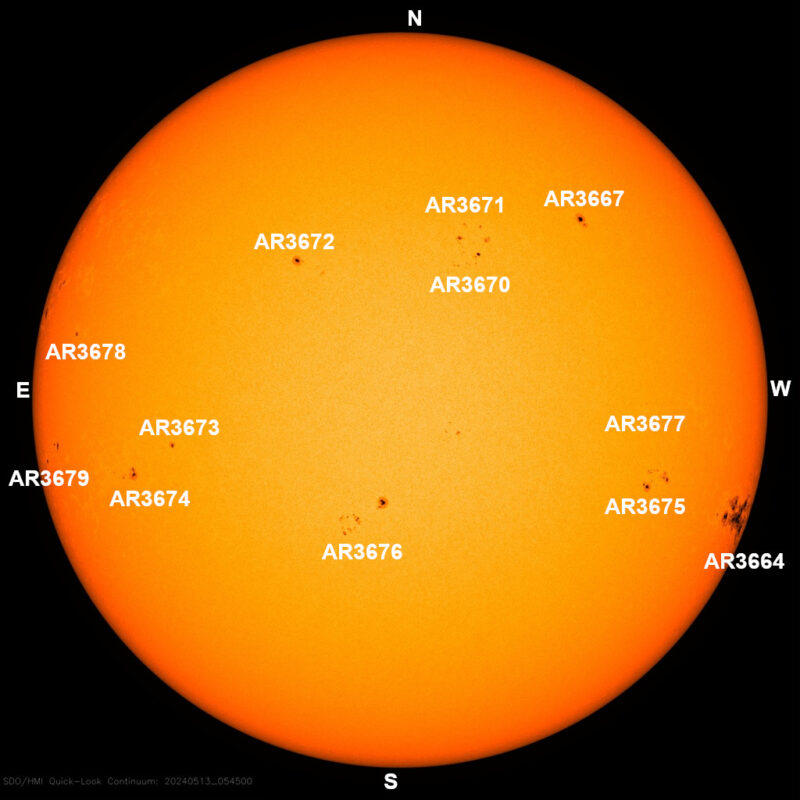



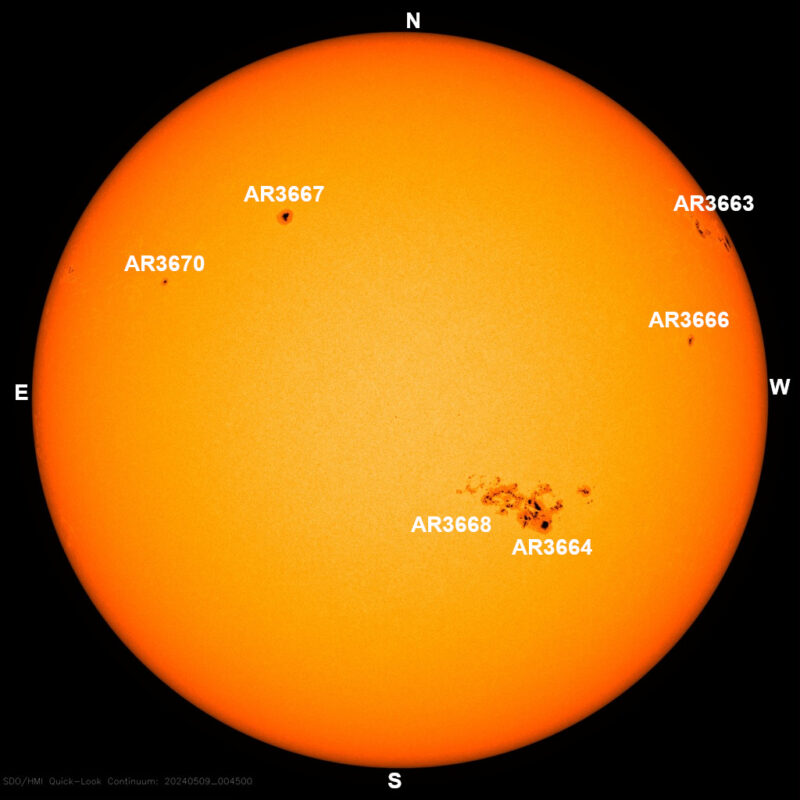
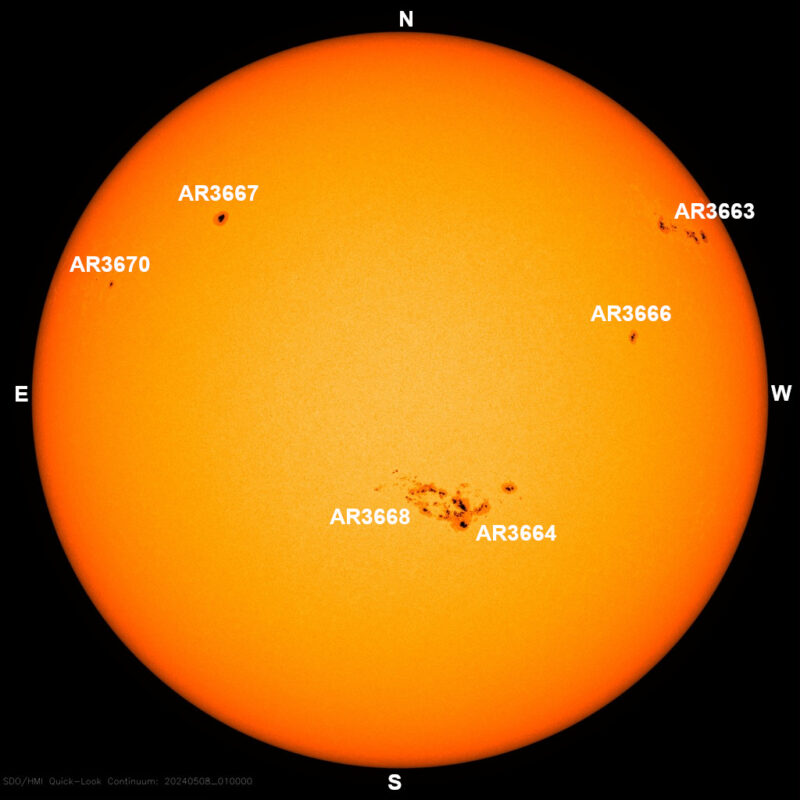
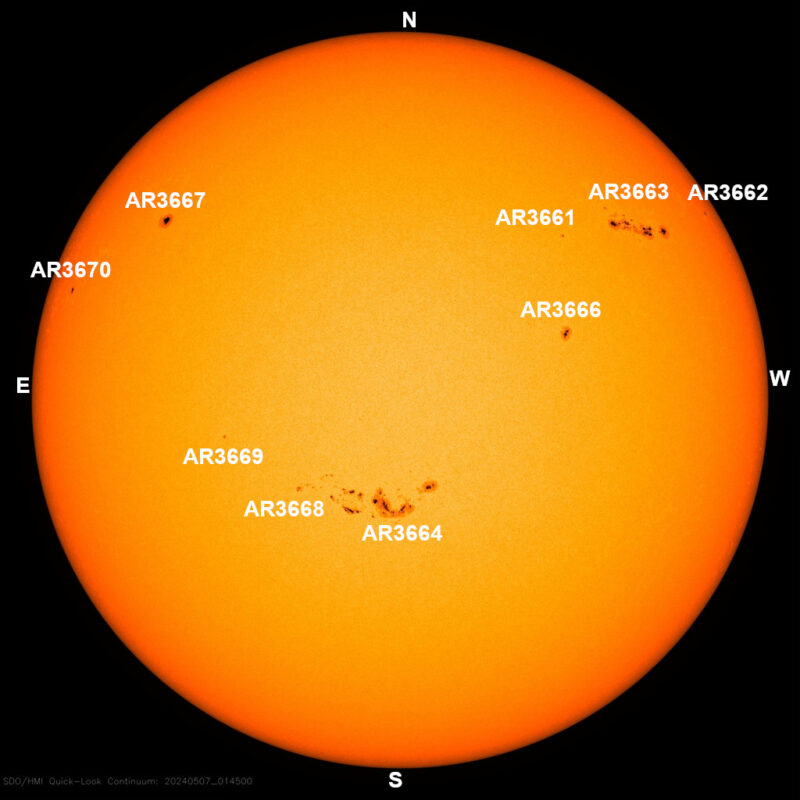
Sun images from our community
Are you a fan of sun images? We invite you all to send us your beautiful recent photos of sunspots and auroras. We love receiving them and sharing them! And to those of you who’ve already posted a photo to our community page, thank you.
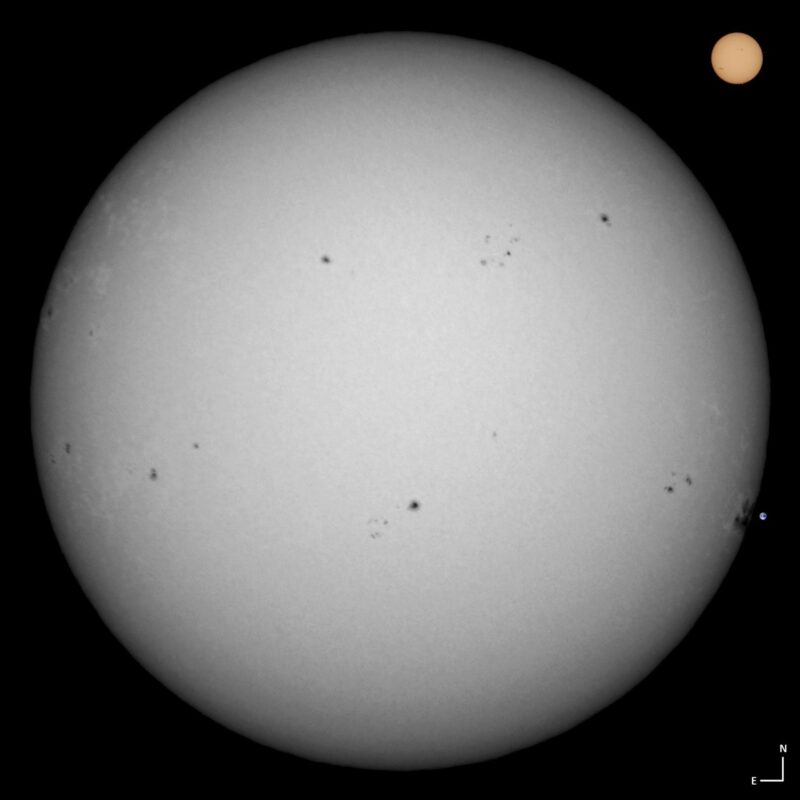
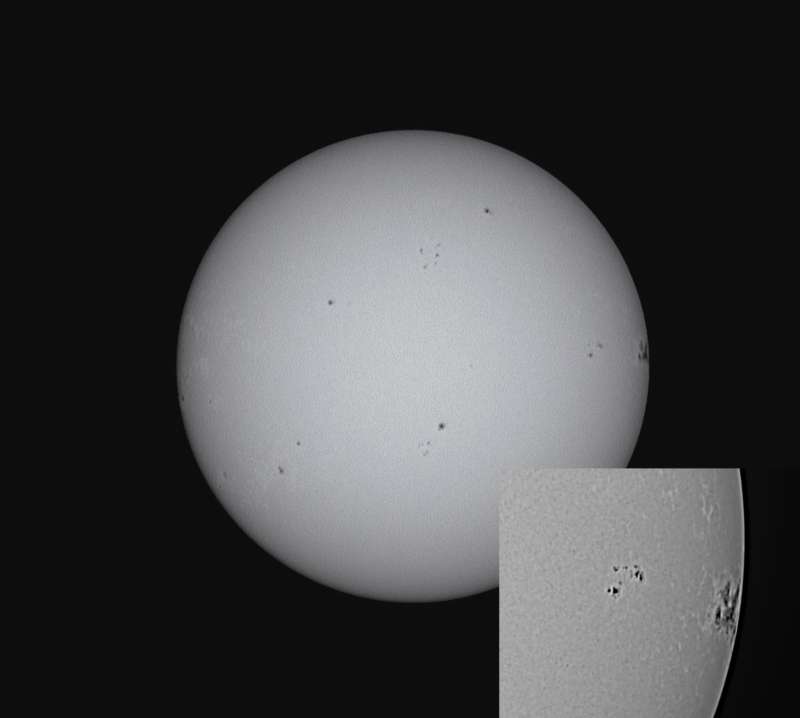
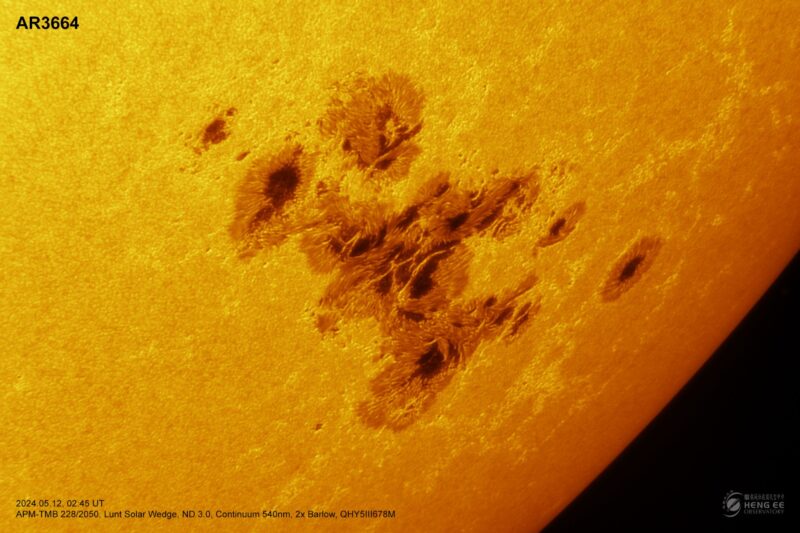
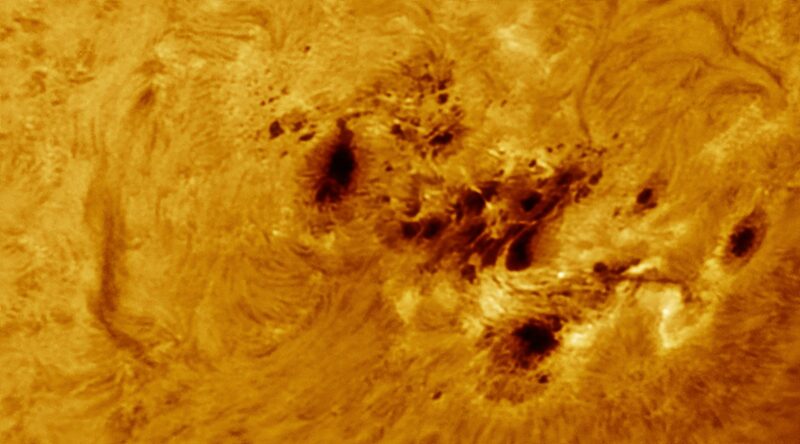

Bottom line: Sun news for May 13, 2024. AR3664 continues to exhibit high activity levels. We are awaiting more CMEs at Earth, and this could mean more auroras tonight and over the next few days. Clear skies!











